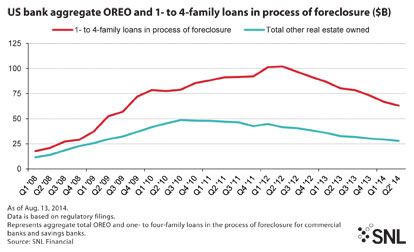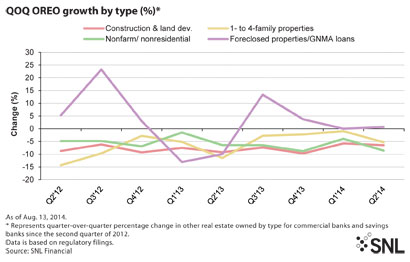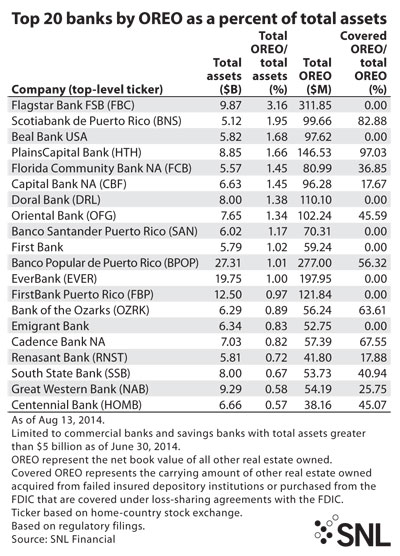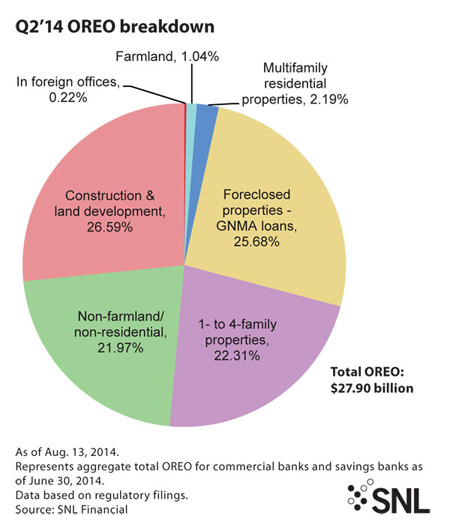OREO hits 5-year low
SNL Report: Less “crunch” these days
- |
- Written by SNL Financial

By Robb Soukup and Salman Aleem Khan, SNL Financial staff writers
Other real estate owned balances—OREO— at U.S. banks continued to edge down during the second quarter, reaching their lowest levels in five years.
Balances fell to $27.90 billion at the end of the quarter, down from $29.36 billion at the end of the first quarter, according to an SNL analysis of OREO across commercial banks and savings banks in the U.S.
One- to four-family loans in the process of foreclosure fell to $63.13 billion, down from $66.78 billion in the previous period. It was the lowest reported total of one- to four-family loans since the third quarter of 2009.
 For a larger version, click on the image.
For a larger version, click on the image.
That total of OREO represented the lowest aggregate balances across the industry since the first quarter of 2009, when banks reported $25.66 billion in OREO, as incremental improvements in housing markets have helped banks bring down those totals.
"It hasn't been dramatic, but the improvement in property values has led to some accelerated activity," David Ruffin, a co-founder and managing member of Credit Risk Management, said.
Shifting regulatory approaches
The continued decline in OREO balances comes as banks have benefited from tax changes which have in some cases eased the costs of working on and disposing of OREO on their balance sheets, though difficulties still remain for banks trying to work down OREO assets on their balance sheets.
Keith Mullen, a member of the firm Higier Allen & Lautin, argued that OREO balances have been somewhat slower to decline than after previous credit cycles. He said there were a number of factors contributing to the slower reductions, including a less vital recovery in some specific housing markets and the broader economy. The pressure that banks are facing from both new regulatory rules and an environment where controlling expenses is important are also limiting their ability to deal with the OREO they carry, according to Mullen, as they funnel resources elsewhere.
"Banks are keeping fewer bank professionals in their OREO group and including fewer of the legal staff—or deploying those people to other areas, such as the regulatory compliance side, because that's a huge growth area," Mullen told SNL.
Makeup of today’s OREO
Declines occurred during the second quarter in nonfarm/residential, construction and land development, and one- to four-family properties. Foreclosed properties and GNMA loans edged higher during the second quarter, rising to $7.16 billion, from $7.12 billion in the first quarter. Foreclosed properties and GNMA loans made up 25.68% of total OREO at the end of the second quarter, the second-largest share of total OREO across the industry.
Construction and land development accounted for the largest share of OREO across the industry, with its total of $7.42 billion representing 26.59% of OREO balances at U.S. banks. One- to four-family properties represented 22.31% of all OREO at the end of the quarter, with banks reporting $6.22 billion at the quarter's end.
Another challenge for banks looking to dispense OREO assets is that potential buyers are aggressive when they know that properties are bank-owned. "That definitely stigmatizes [the asset]. … Buyers are going to value it differently," Mullen said.
Ruffin agreed, saying that "certainly it's difficult for many investors or buyers, because you have eclectic properties, and they all have different valuation issues."
 For a larger version, click on the image.
For a larger version, click on the image.
Looking at individual banks’ results
The industry's largest players continued to easily carry the largest total amounts of one- to four-family loans in the process of foreclosure, though each of the four largest banks in the U.S. reported declines in that number from their first quarter levels.
Wells Fargo Bank NA reported one- to four-family loans in the process of foreclosure of $15.85 billion, compared with $17.44 billion at the end of the first quarter, and Bank of America NA reported that one- to four-family loans in the process of foreclosure fell to $12.60 billion, from $12.89 billion.
JPMorgan Chase Bank NA said that total was $12.01 billion at the end of the quarter—falling from $12.64 billion at the end of the prior quarter.
 For a larger version, click on the image.
For a larger version, click on the image.
Flagstar Bancorp Inc. reported the largest amount of OREO as a percentage of total assets, at 3.16%, according to SNL's analysis. That was up from 3.03% at the end of the previous quarter and came despite an increase in the company's amount of total assets, as the company's aggregate amount of total OREO rose to $311.9 million during the period —an increase from a total balance of $289.8 million.
That put the company well ahead of the bank reporting the next-highest amount of OREO compared to total assets. Scotiabank de Puerto Rico reported total OREO of $99.7 million, or 1.95% of assets, at the end of the quarter, and Beal Bank USA had total OREO balances of $97.6 million, or about 1.68% of its total assets. Nearly 82.88% of Scotiabank's total OREO was covered by FDIC loss-share agreements, and a number of other banks reported that a large chunk of their OREO balance was associated with FDIC failed bank transactions.
PlainsCapital Bank, a unit of Hilltop Holdings Inc., said that 97.03% of its total OREO was covered by those agreements. Bank of the Ozarks, which was an aggressive acquirer of failed institutions throughout the credit cycle, said that 63.61% of its $56.2 million in total OREO is covered under its loss-share deals with the FDIC.















